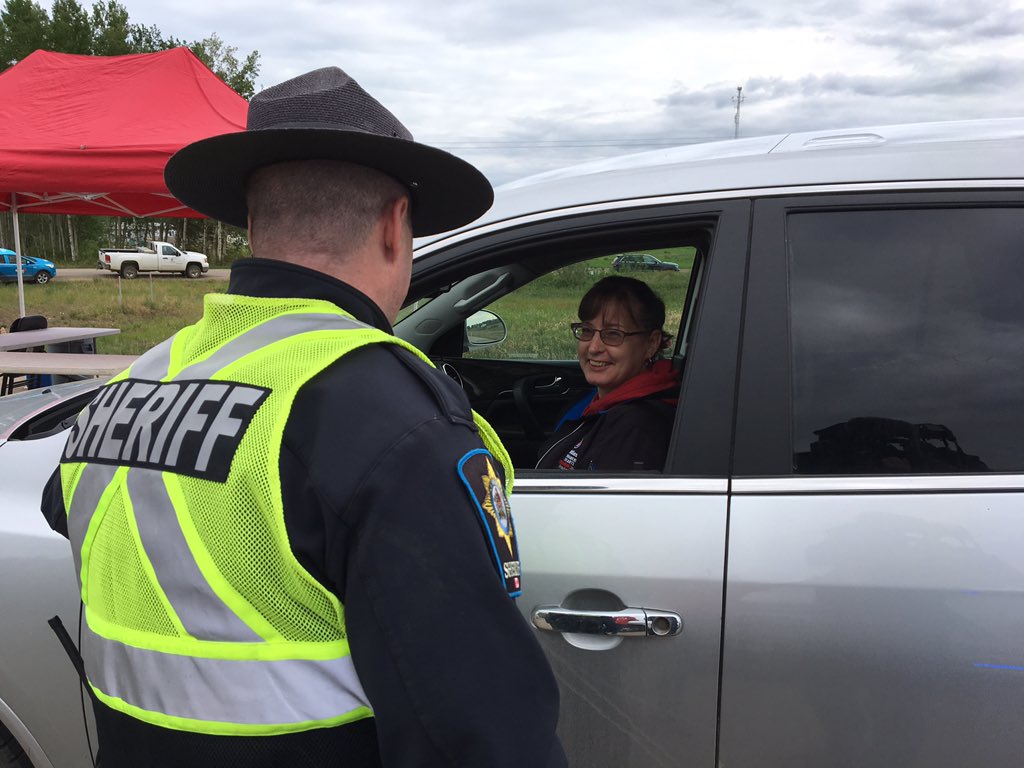An estimated 8,100 northwestern Alberta residents evacuated due to wildfires were allowed to begin returning home Tuesday.

The government said a shift in weather, including rain in recent days, has helped firefighters in the High Level region.
The Chuckegg and Jackpot Creek Wildfires in the area remain out of control, but the province said crews are making progress and the Chuckegg wildfire did not grow on Monday.
WATCH: Emotional video of toddler seeing Paddle Prairie home destroyed by wildfire
Residents in the following communities of Mackenzie County were able to return home Monday night:
- The Rocky Lane and High Level area north of the Peace River, south of Highway 58, west of Range Road 150 and south and southeast of High Level
- The Hamlet of La Crete and the rural area outside the hamlet
- Range Road 164 to Range Road 150, south of the Peace River, north and south of Highway 697
Approximately 900 people in the following communities will be able to begin returning home Tuesday:
- Beaver First Nation – Boyer River (No. 164) and Child Lake (No. 164A)
- Dene Tha’ First Nation – Bushe River (No. 207)
A boil water advisory is in place for Meander River on the Dene Tha’ First Nation.
An evacuation alert remains in effect for High Level, as well as Mackenzie County west of Range Road 164, south of the Peace River to Township Road 1010, and the Machesis Lake campground.

Get daily National news
Those residents should remain ready to leave at a moment’s notice, in the event conditions change and the wildfire flares up again.
- Calgary couple find their ‘Zen’ through axe throwing, compete in world championships
- 2nd-degree Banff murder conviction ‘won’t bring my boy back’: Mother
- Recall expands for Nutrabolics vegan bars over undeclared milk
- Frost coming to parts of Alberta — here’s what you need to harvest from your garden
READ MORE: Alberta wildfire evacuation alerts and orders in place across the province
The province said people from the following communities are eligible for the one-time evacuation payment: Mackenzie County, Beaver First Nation, Tompkins Landing, Blue Hills and the Hamlet of La Crete.
Residents who qualify can receive $1,250 and $500 for each dependent child under 18 living in the same home when the evacuation order was given.
Wildfire update
The wildfire risk in the region is still high, but scattered showers are helping.
As of Monday night, the Chuckegg Creek wildfire southwest of High Level was about 331,900 hectares and had 1,053 firefighters and personnel, 311 pieces of heavy equipment and 46 helicopters working on it.
The wildfire has grown less than 10,000 hectares in the past week, when cold, wet weather moved in.
READ MORE: Tough return for Paddle Prairie Métis Settlement after Alberta wildfire: ‘It hurts to see’
The province said rain fell in the area on Monday, and similar weather was expected Tuesday with temperatures in the low 20s, low winds and a 70 per cent chance of thundershowers with one to five millimetres of rain expected.
While there was no growth of the fire, there were still hotspots and smoke visible within the perimeter especially on the east flank of the fire, west of the community of La Crete.
An infrared scan was done Monday night to map out more hotspots to be extinguished and the existing structure protection remained in place as a precautionary measure.
The Jackpot Creek wildfire north of High Level was about 77,400 hectares and had 194 firefighters and personnel, five pieces of heavy equipment and 25 helicopters working on it.
The weather forecast for this fire was expected to be the similar to the last few days with cooler, damp weather. Fire bans and off-highway vehicle restrictions remain in effect for this part of northwestern Alberta.
READ MORE: Evacuation order lifted for Indian Cabins community but wildfire threat remains
Further southeast towards the middle of northern Alberta, the McMillan Wildfire Complex in the Slave Lake Forest area was more than 273,000 hectares. The complex is made up of four different wildfires, with three under control and one being held as of Monday night.
There are 504 firefighters and support staff, 45 helicopters, airtankers and 59 pieces of heavy equipment fighting the wildfire.
The wildfire risk is low due to scattered rain and cooler conditions, and the fire ban and off-highway vehicle restriction were lifted for that area.
READ MORE: 2019 has seen the driest spring on record for some Alberta communities










Comments